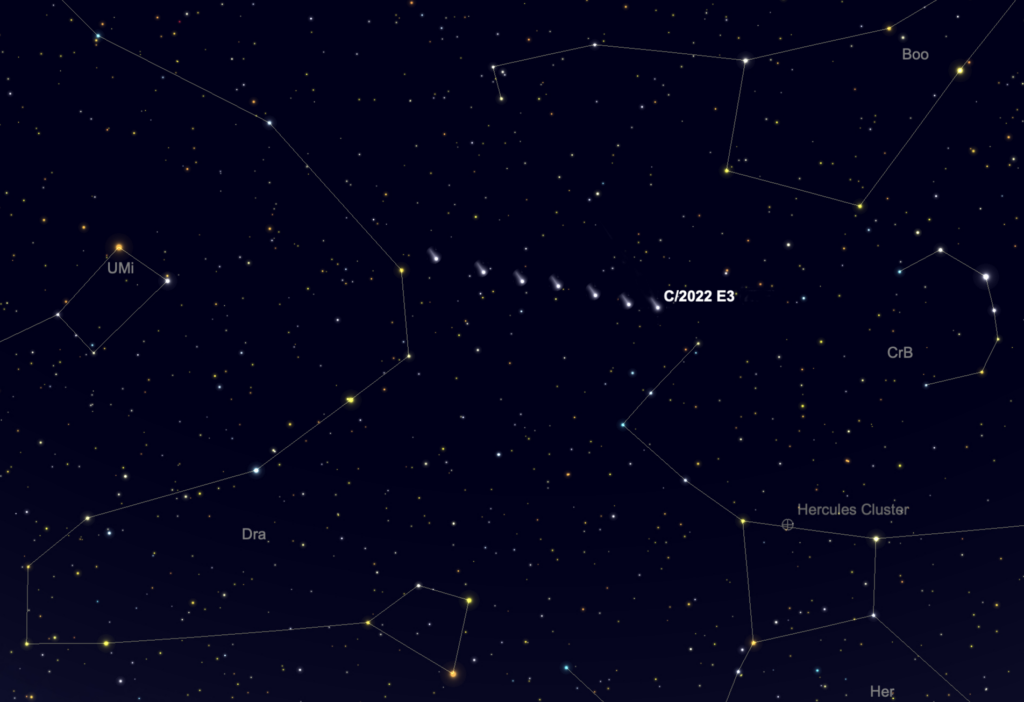Sky Report: January 16 – 22

Caption: this week the comet moves northward from northern Bootes across Draco. It is shown at 5 a.m. on the mornings of the 17th (right) to 23rd (left). Graphic created with SkySafariAstronomy.com.
Comet C/2022 E3 should be bright enough to spot with binoculars and possibly even the unaided eye. It made its closest approach to the sun last week and it will be closest to the earth in two weeks, so now and for the next few weeks it’ll be as bright as it will get. Predictions put it at naked-eye visibility IF you have a dark sky and know precisely where to look. Fortunately the moon is out of the way these two weeks. The comet is moving rapidly northward through the northern part of Bootes into Draco, roughly 30° from the North Star. The best time to look is around 4-5 a.m., when it’s risen high enough but before the sun brightens the sky with the approaching dawn. I’ve not found a good chart on the web, so I provide one here; far better is to use an app like Sky Safari with a zoomable star chart. Expect to see a faint smudge with possibly a stubby tail that moves noticeably night to night, so enjoy following its motion.
Beginning next week the comet moves into the evening sky — to everyone’s delight!
Turning to this week’s evening sky, the three brightest planets are beautifully placed, plus there’s a great conjunction with the fourth.
Look early; Venus, the brightest, is only 10° high 45 minutes after sunset, and it sets 1h 45m after the sun. You’ll see Venus in twilight so there will be great photo opportunities if the sunset is colorful and Venus shines through a break in the clouds. Venus’ brilliance will make it obvious if hills etc. are not in the way.
Venus is moving eastward against the more distant planets and the stars and this week it approaches Saturn, which is above Venus but only 1/75th as bright. Mark your calendars: on the 21st they’re separated by 1° and on the 22nd by a scant ¼°, which is ½ the diameter of the moon, and they’ll appear together in a telescope. Note that Venus, on the far side of the sun, is virtually full (93% illuminated) as Galileo first saw 413 years ago. Venus then moves on toward Jupiter; from your own observations when do you estimate Venus will pass Jupiter?
As darkness falls Jupiter is halfway up the southwestern sky where it’s far brighter than any star.
The third bright planet is Mars, which at the same time is 2/3 of the way up the southeastern sky. Mars is in a crowded part if the Milky Way where it’s surrounded by bright stars – and it’s equidistant from two big and bright star clusters – the Pleiades to the right and the Hyades below. Mars is in Taurus; straight below it is Orion and below Orion is the brightest star Sirius in Canis Major, the Large Dog. Just below Mars is the orange star Aldebaran while to the north is Capella in Auriga and farther to the left are the Gemini twins.
The Sky Report is presented as a public service by the Stellar Vista Observatory, a nonprofit organization based in Kanab, Utah, which provides opportunities for people to observe, appreciate, and comprehend our starry night sky. Additional information is at www.stellarvistaobservatory.org. Send questions and comments to John@StargazingAdventures.org.
Stellar Vista Observatory provides portable telescopes and tripod mounted binocular kits on loan for free to residents and visitors in Kane County. Enhance your enjoyment of the night sky! For details or to request a loan, visit https://stellarvistaobservatory.org/discover-the-night-sky/ or drop in to the Kane County Office of Tourism.





Comments are closed.